By Ray Tricca, SBS Equine
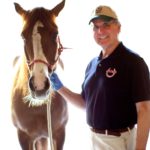
For decades hoof researchers have been trying to invent the ideal hoof conditioner. We now know that this goal is more of a process rather than an end game. After 32 years in the research & development end of the hoof care business, these are some of the things we have learned so far:
Maintaining A Healthy Hoof
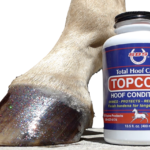 The hoof wall is the weight bearing structure of the hoof and it is composed of thousands of tiny hollow fibers called tubules. These tubules run vertically from the coronary band and are cemented together with a protein substance called keratin. Layer upon layer of these tubules act effectively as springs to absorb tremendous amounts of concussive force while retaining the necessary tensile strength. The elasticity of these tubules and the hoof wall in general is dependent on its internal moisture content of which 90% is derived from the blood and lymph vessels.
The hoof wall is the weight bearing structure of the hoof and it is composed of thousands of tiny hollow fibers called tubules. These tubules run vertically from the coronary band and are cemented together with a protein substance called keratin. Layer upon layer of these tubules act effectively as springs to absorb tremendous amounts of concussive force while retaining the necessary tensile strength. The elasticity of these tubules and the hoof wall in general is dependent on its internal moisture content of which 90% is derived from the blood and lymph vessels.
This moisture is not simply water, but a mix of salts and electrolytes much like that found in an I.V. solution. Without this essential moisture, the hoof wall would dry up, crack, become brittle and generally fail at its job of a leaf spring/shock absorber. Too much moisture, on the other hand, can make a hoof too soft, mushy and fail to absorb its concussive load. We now understand that the #1 function of a hoof conditioner must be to help maintain the natural moisture balance found within the hoof.
Pine Tar
Grandpa and his grandfather before him intuitively used pine tar to help the hoof maintain the hoof’s natural moisture balance to 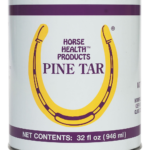 resist chipping and cracking. Pine tar usually remains fluid (wet), sticky, and can attract contaminants instead of repelling them. Their application actually may be counter-productive because they can serve as a bacterial and/or fungal growth medium when they fester in a small crack or nail hole. Pine tar, unfortunately, has its drawbacks, but Grandpa was on the right track.
resist chipping and cracking. Pine tar usually remains fluid (wet), sticky, and can attract contaminants instead of repelling them. Their application actually may be counter-productive because they can serve as a bacterial and/or fungal growth medium when they fester in a small crack or nail hole. Pine tar, unfortunately, has its drawbacks, but Grandpa was on the right track.
Hoof Oil
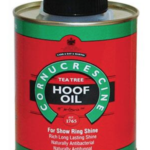 Later came products that contain oils made from plants and animals. Most hoof oils are really organic fats with fancy names. Some of these names may sound familiar… lanolin, emu oil, fish oil, neat foot oil and beeswax are all classified as an animal fat…vegetables fats (oils) are from plants that include tea tree oil, aloe vera, pine tar, caster oil, linseed oil, cottoned oil, wheat germ oil, peppermint oil, jojoba oil, avocado oil, etc.
Later came products that contain oils made from plants and animals. Most hoof oils are really organic fats with fancy names. Some of these names may sound familiar… lanolin, emu oil, fish oil, neat foot oil and beeswax are all classified as an animal fat…vegetables fats (oils) are from plants that include tea tree oil, aloe vera, pine tar, caster oil, linseed oil, cottoned oil, wheat germ oil, peppermint oil, jojoba oil, avocado oil, etc.
These fats work by temporarily sealing-in the internal moisture in the hoof to help them maintain their flexibility. Basically, sealing the outside of the hoof wall with a layer of fat is how a hoof is moisturized with oil. The good news is that these organic oils are plentiful and cheap. This is why fats have been used for centuries as a moisturizer.
The downside of using hoof oils is that they usually remain fluid (wet & sticky) after they are applied to the hoof and often attract contaminants instead of repelling them. They also tend to breakdown quickly when exposed to the environment, especially in wet conditions, and need to be reapplied frequently. The ability of hoof oils to fight fungus and bacteria is misleading. These trace elements in the oils do not benefit the surrounding hoof tissue because they are self contained and do not released to surrounding tissue. Their natural function is to preserve the oil.
Synthetic Coatings
In the mid-1980’s, hoof researchers began developing a new class of hoof conditioners made from petroleum derivatives. 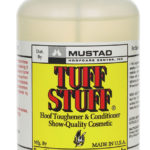 Urethane polymers, mineral oil and various nail polish formulas containing acetone and formaldehyde solvents have been introduced over the years with limited success. When applied to the hoof, they cure quickly to provide a longer lasting cosmetic shine. Synthetic coatings are impervious to water and help the hoof wall remain flexible by sealing-in the natural moisture from the animal’s blood supply.
Urethane polymers, mineral oil and various nail polish formulas containing acetone and formaldehyde solvents have been introduced over the years with limited success. When applied to the hoof, they cure quickly to provide a longer lasting cosmetic shine. Synthetic coatings are impervious to water and help the hoof wall remain flexible by sealing-in the natural moisture from the animal’s blood supply.
However, there are two major draw-backs with synthetic hoof sealants that limit their usefulness. They should be applied only to the hoof wall and not to the bottom of the feet (sole and frog) where the hoof needs to breathe. Synthetic sealants prevent moisture transpiration (do not breathe). They are useful to the hoof wall and not to the sole and frog. Also, synthetic formulas typically contain acetone and other drying agents which are harmful to the hoof and to the environment.
Dual-Action Hoof Conditioners
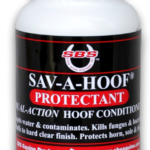 A new generation of hoof conditioners has become available is recent years. The thinking now is to treat the entire hoof capsule ( hoof wall, sole & frog) and not just the hoof wall with a hoof conditioner. All parts of the hoof need to function at maximum efficiency to truly have a healthy hoof condition. Dual-Action hoof conditioners treat the entire hoof capsule and perform two major functions: 1) they help maintain the natural moisture balance in the hoof for natural flexibility and 2) protect the hoof against infection.
A new generation of hoof conditioners has become available is recent years. The thinking now is to treat the entire hoof capsule ( hoof wall, sole & frog) and not just the hoof wall with a hoof conditioner. All parts of the hoof need to function at maximum efficiency to truly have a healthy hoof condition. Dual-Action hoof conditioners treat the entire hoof capsule and perform two major functions: 1) they help maintain the natural moisture balance in the hoof for natural flexibility and 2) protect the hoof against infection.
Dual-action hoof conditioners allow the hoof to breathe. They contain organic protein emulsions that cure to a dry, battle hardened finish that does not wash away easily. They also contain broad-based biocides that reach deeply rooted bacteria & fungi without harming the surrounding healthy hoof tissue and are safe for the environment.
Grandpa would have been proud to use these products, had the technology existed in his day. Thanks Grandpa for getting us this far! For more informative articles on hoof care please visit: SBS Equine.




